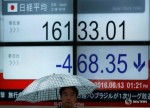
- All Instrument Types
- Indices
- Equities
- ETFs
- Funds
- Commodities
- Currencies
- Crypto
- Bonds
- Certificates
Please try another search

Chinese Economic Growth Loses Momentum At End Of Q1

- Caixin Composite PMI Output Index slips to 51.8 in March, down from 53.3 in February
- Employment falls as services jobs growth slows
- Mixed outlook with slower new business growth but strong confidence towards the 12-month outlook
March PMI survey data signalled a noticeable loss of momentum in China’s economic growth, raising questions over whether business activity will expand at a slower pace in coming months after a stronger than expected start to the year. The latest upturn was also accompanied by a renewed fall in employment.
Best quarter since Q4 2016
The Caixin Composite PMI™ Output Index fell from 53.3 in February to 51.8 in March, signalling a modest improvement in the health of the economy. Despite the decline, the strong performance in the previous two months means the average PMI reading for the first quarter was the highest for over a year. However, the latest data paint a markedly different picture to prior months, suggesting growth momentum has been lost to a significant extent.
China PMI and economic growth

While growth remained broad-based, the pace of expansion in both manufacturing output and services activity slowed in March. Softer increases in business activity coincided with weaker new business growth in both monitored sectors, calling into question whether further momentum could be lost in the months ahead.
Broad-based upturn

Weak employment
Additional concerns about the outlook are flagged by the deteriorating labour market. March survey data showed the first drop in overall employment numbers since last October, contrasting with the broad stabilisation seen in prior months. While mild, the pace of contraction was the fastest since July last year. Services job gains were insufficient to offset a steeper rate of job shedding in the manufacturing sector. Employment in the service sector rose at the weakest pace for 19 months.
China employment

Cooling inflation
There were further signs of easing cost pressures at the end of the first quarter. March saw a marked slowdown in the growth of input costs, with inflation running at the weakest for eight months. With a steady rise in average selling prices reported during the month, slower cost inflation placed less pressure on companies’ profit margins, which ought to bolster their ability to service debts.
Higher costs were mainly linked to increased prices for raw materials, in particular metals.
China PMI and consumer inflation

Outlook
The outlook appears mixed. Growth in composite new orders softened to a six-month low, but business expectations of output in the year ahead improved to the highest since June 2017.
The government recently announced a GDP growth target of around 6.5% this year, down from the actual expansion of 6.9% in 2017. It also reaffirmed commitments to further cut industrial overcapacity and reduce pollution, both of which are widely expected to weigh on output from the heavy industrial sector.
Disclaimer: The intellectual property rights to these data provided herein are owned by or licensed to Markit Economics Limited. Any unauthorised use, including but not limited to copying, distributing, transmitting or otherwise of any data appearing is not permitted without Markit’s prior consent. Markit shall not have any liability, duty or obligation for or relating to the content or information (“data”) contained herein, any errors, inaccuracies, omissions or delays in the data, or for any actions taken in reliance thereon.
In no event shall Markit be liable for any special, incidental, or consequential damages, arising out of the use of the data. Purchasing Managers' Index™ and PMI™ are either registered trademarks of Markit Economics Limited or licensed to Markit Economics Limited. Markit is a registered trade mark of Markit Group Limited.
Related Articles

Interest rate deliberations remain the central theme this week, with the Bank of England revealing its latest decision later. The central bank has been between a rock and a hard...

As widely expected, the Fed cut the Fed Funds rate by 25bps, to 4.25-4.50%, at Wednesday's FOMC meeting. Moreover, they intimated that after cutting rates by 1% since September,...

We got another 25bp policy rate cut from the Fed, but updated projections and Chair Powell’s press conference confirm that the Fed is going to be much more cautious next year with...
Are you sure you want to block %USER_NAME%?
By doing so, you and %USER_NAME% will not be able to see any of each other's Investing.com's posts.
%USER_NAME% was successfully added to your Block List
Since you’ve just unblocked this person, you must wait 48 hours before renewing the block.
I feel that this comment is:
Thank You!
Your report has been sent to our moderators for review




Add a Comment
We encourage you to use comments to engage with users, share your perspective and ask questions of authors and each other. However, in order to maintain the high level of discourse we’ve all come to value and expect, please keep the following criteria in mind:
Perpetrators of spam or abuse will be deleted from the site and prohibited from future registration at Investing.com’s discretion.